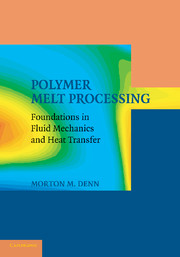Book contents
- Frontmatter
- Contents
- Preface
- 1 Polymer Processing
- 2 Fundamentals
- 3 Extrusion
- 4 Temperature and Pressure Effects in Flow
- 5 The Thin Gap Approximation
- 6 Quasi-Steady Analysis of Mold Filling
- 7 Fiber Spinning
- 8 Numerical Simulation
- 9 Polymer Melt Rheology
- 10 Viscoelasticity in Processing Flows
- 11 Stability and Sensitivity
- 12 Wall Slip and Extrusion Instabilities
- 13 Structured Fluids
- 14 Mixing and Dispersion
- Postface
- Author Index
- Subject Index
- Plate section
- References
14 - Mixing and Dispersion
Published online by Cambridge University Press: 05 June 2012
- Frontmatter
- Contents
- Preface
- 1 Polymer Processing
- 2 Fundamentals
- 3 Extrusion
- 4 Temperature and Pressure Effects in Flow
- 5 The Thin Gap Approximation
- 6 Quasi-Steady Analysis of Mold Filling
- 7 Fiber Spinning
- 8 Numerical Simulation
- 9 Polymer Melt Rheology
- 10 Viscoelasticity in Processing Flows
- 11 Stability and Sensitivity
- 12 Wall Slip and Extrusion Instabilities
- 13 Structured Fluids
- 14 Mixing and Dispersion
- Postface
- Author Index
- Subject Index
- Plate section
- References
Summary
Laminar Mixing
Mixing and blending in polymer processing applications almost always takes place in the laminar regime. The basic idea in laminar mixing is straightforward: Adjacent laminae of dissimilar materials are stretched – let us say doubled in length – so that the thicknesses of the laminae are reduced by a factor of two. The stretched sections are then folded back to create a block of the same thickness as the original, but it now contains four lamina instead of the original two. This process is repeated, and the number of lamina grows as 2N, where N is the number of stretching/folding steps, while the thicknesses decrease as 2-N. This process is known as the baker's transformation, for it is precisely the sequence of steps that is carried out in kneading a loaf of bread. (Push down to stretch, then fold back, turn 90°, and repeat.) Laminar mixing is related to the theory of chaotic dynamical systems, and it has been widely studied in the context of dynamical systems since the late 1980s.
The implementation of this methodology in polymer processing long predates the development of the theoretical tools currently in use for analysis. Static mixers are commonly employed to effect the baker's transformation. A cutaway view of a Kenics static mixer is shown in Figure 14.1. This device consists of a series of helically twisted blades that divide the circular channel into two twisted semicircular ducts.
- Type
- Chapter
- Information
- Polymer Melt ProcessingFoundations in Fluid Mechanics and Heat Transfer, pp. 231 - 238Publisher: Cambridge University PressPrint publication year: 2008



